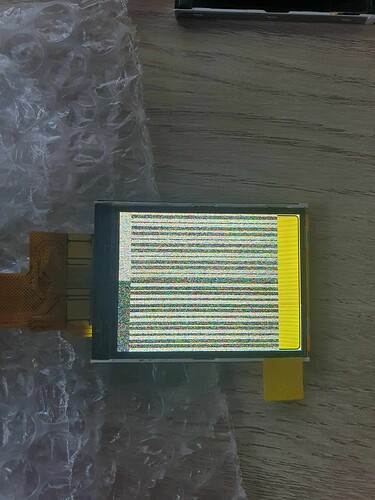/*
* SPDX-FileCopyrightText: 2021 Espressif Systems (Shanghai) CO LTD
*
* SPDX-License-Identifier: CC0-1.0
*/
#include <stdio.h>
#include "freertos/FreeRTOS.h"
#include "freertos/task.h"
#include "esp_timer.h"
#include "esp_lcd_panel_io.h"
#include "esp_lcd_panel_vendor.h"
#include "esp_lcd_panel_ops.h"
#include "driver/gpio.h"
#include "esp_err.h"
#include "esp_log.h"
#include "lvgl.h"
#include "driver/spi_master.h"
static const char *TAG = "example";
////////////////////////////////////////////////////////////////////////////////////////////////////////////////////////
//////////////////// Please update the following configuration according to your LCD spec //////////////////////////////
////////////////////////////////////////////////////////////////////////////////////////////////////////////////////////
#define EXAMPLE_LCD_PIXEL_CLOCK_HZ (80 * 1000 * 1000)
#define EXAMPLE_LCD_BK_LIGHT_ON_LEVEL 1
#define EXAMPLE_LCD_BK_LIGHT_OFF_LEVEL !EXAMPLE_LCD_BK_LIGHT_ON_LEVEL
// LCD
#define LCD_HOST SPI2_HOST
#define EXAMPLE_PIN_NUM_BK_LIGHT GPIO_NUM_9 //IO9, PIN17
#define EXAMPLE_PIN_RD GPIO_NUM_47 //IO10, PIN18
//#define EXAMPLE_PIN_NUM_LCD_DC GPIO_NUM_47
#define EXAMPLE_PIN_NUM_RST GPIO_NUM_11
#define EXAMPLE_PIN_NUM_CS GPIO_NUM_13
#define EXAMPLE_PIN_NUM_SCLK GPIO_NUM_21
#define EXAMPLE_PIN_NUM_MOSI GPIO_NUM_14
#define EXAMPLE_PIN_NUM_MISO GPIO_NUM_12
// The pixel number in horizontal and vertical
#define EXAMPLE_LCD_H_RES 320
#define EXAMPLE_LCD_V_RES 240
// Bit number used to represent command and parameter
#define EXAMPLE_LCD_CMD_BITS 8
#define EXAMPLE_LCD_PARAM_BITS 8
#define EXAMPLE_LVGL_TICK_PERIOD_MS 2
extern void example_lvgl_demo_ui(lv_obj_t *scr);
static bool example_notify_lvgl_flush_ready(esp_lcd_panel_io_handle_t panel_io, esp_lcd_panel_io_event_data_t *edata, void *user_ctx)
{
lv_disp_drv_t *disp_driver = (lv_disp_drv_t *)user_ctx;
lv_disp_flush_ready(disp_driver);
return false;
}
static void example_lvgl_flush_cb(lv_disp_drv_t *drv, const lv_area_t *area, lv_color_t *color_map)
{
esp_lcd_panel_handle_t panel_handle = (esp_lcd_panel_handle_t) drv->user_data;
int offsetx1 = area->x1;
int offsetx2 = area->x2;
int offsety1 = area->y1;
int offsety2 = area->y2;
// copy a buffer's content to a specific area of the display
esp_lcd_panel_draw_bitmap(panel_handle, offsetx1, offsety1, offsetx2 + 1, offsety2 + 1, color_map);
}
static void example_increase_lvgl_tick(void *arg)
{
/* Tell LVGL how many milliseconds has elapsed */
lv_tick_inc(EXAMPLE_LVGL_TICK_PERIOD_MS);
}
void app_main(void)
{
static lv_disp_draw_buf_t disp_buf; // contains internal graphic buffer(s) called draw buffer(s)
static lv_disp_drv_t disp_drv; // contains callback functions
ESP_LOGI(TAG, "Turn off LCD backlight");
gpio_config_t bk_gpio_config = {
.mode = GPIO_MODE_OUTPUT,
.pin_bit_mask = 1ULL << EXAMPLE_PIN_NUM_BK_LIGHT
};
ESP_ERROR_CHECK(gpio_config(&bk_gpio_config));
gpio_set_level(EXAMPLE_PIN_NUM_BK_LIGHT, EXAMPLE_LCD_BK_LIGHT_OFF_LEVEL);
// 1.Create an SPI bus
ESP_LOGI(TAG, "Initialize LCD SPI bus");
spi_bus_config_t buscfg = {
.sclk_io_num = EXAMPLE_PIN_NUM_SCLK,
.mosi_io_num = EXAMPLE_PIN_NUM_MOSI,
.miso_io_num = EXAMPLE_PIN_NUM_MISO,
.quadwp_io_num = -1, // Quad SPI LCD driver is not yet supported
.quadhd_io_num = -1, // Quad SPI LCD driver is not yet supported
.data4_io_num = -1,
.data5_io_num = -1,
.data6_io_num = -1,
.data7_io_num = -1,
.flags = SPICOMMON_BUSFLAG_MASTER | SPICOMMON_BUSFLAG_GPIO_PINS,
.max_transfer_sz = EXAMPLE_LCD_H_RES * EXAMPLE_LCD_V_RES * 2 / 10, // transfer 80 lines of pixels (assume pixel is RGB565) at most in one SPI transaction
};
ESP_ERROR_CHECK(spi_bus_initialize(LCD_HOST, &buscfg, SPI_DMA_CH_AUTO)); // Enable the DMA feature
// 2. LCD IO device handle
esp_lcd_panel_io_handle_t io_handle = NULL;
esp_lcd_panel_io_spi_config_t io_config = {
.dc_gpio_num = 47,//EXAMPLE_PIN_NUM_LCD_DC,
.cs_gpio_num = EXAMPLE_PIN_NUM_CS,
.pclk_hz = EXAMPLE_LCD_PIXEL_CLOCK_HZ,
.lcd_cmd_bits = EXAMPLE_LCD_CMD_BITS,
.lcd_param_bits = EXAMPLE_LCD_PARAM_BITS,
.spi_mode = 0,
.trans_queue_depth = 10,
.on_color_trans_done=example_notify_lvgl_flush_ready,
.user_ctx=&disp_drv,
.dc_low_on_data=false,
.cs_high_active=true
};
// Attach the LCD to the SPI bus
ESP_ERROR_CHECK(esp_lcd_new_panel_io_spi((esp_lcd_spi_bus_handle_t)LCD_HOST, &io_config, &io_handle));
ESP_LOGI(TAG, "Install LCD driver of st7789");
esp_lcd_panel_handle_t panel_handle = NULL;
esp_lcd_panel_dev_config_t panel_config = {
.reset_gpio_num = EXAMPLE_PIN_NUM_RST,
.color_space = ESP_LCD_COLOR_SPACE_RGB,
.bits_per_pixel = 16,
};
ESP_ERROR_CHECK(esp_lcd_new_panel_st7789(io_handle, &panel_config, &panel_handle));
esp_lcd_panel_reset(panel_handle);
esp_lcd_panel_init(panel_handle);
esp_lcd_panel_invert_color(panel_handle, true);
// the gap is LCD panel specific, even panels with the same driver IC, can have different gap value
esp_lcd_panel_set_gap(panel_handle, 0, 0);
ESP_LOGI(TAG, "Turn on LCD backlight");
gpio_set_level(EXAMPLE_PIN_NUM_BK_LIGHT, EXAMPLE_LCD_BK_LIGHT_ON_LEVEL);
ESP_LOGI(TAG, "Initialize LVGL library");
lv_init();
// alloc draw buffers used by LVGL
// it's recommended to choose the size of the draw buffer(s) to be at least 1/10 screen sized
lv_color_t *buf1 = heap_caps_malloc(EXAMPLE_LCD_H_RES * EXAMPLE_LCD_V_RES * 2 / 10, MALLOC_CAP_DMA);
assert(buf1);
lv_color_t *buf2 = heap_caps_malloc(EXAMPLE_LCD_H_RES * EXAMPLE_LCD_V_RES * 2 / 10, MALLOC_CAP_DMA);
assert(buf2);
// initialize LVGL draw buffers
lv_disp_draw_buf_init(&disp_buf, buf1, buf2, EXAMPLE_LCD_H_RES * EXAMPLE_LCD_V_RES * 2 / 10);
ESP_LOGI(TAG, "Register display driver to LVGL");
lv_disp_drv_init(&disp_drv);
disp_drv.hor_res = EXAMPLE_LCD_H_RES;
disp_drv.ver_res = EXAMPLE_LCD_V_RES;
disp_drv.flush_cb = example_lvgl_flush_cb;
disp_drv.draw_buf = &disp_buf;
disp_drv.user_data = panel_handle;
lv_disp_t *disp = lv_disp_drv_register(&disp_drv);
ESP_LOGI(TAG, "Install LVGL tick timer");
// Tick interface for LVGL (using esp_timer to generate 2ms periodic event)
const esp_timer_create_args_t lvgl_tick_timer_args = {
.callback = &example_increase_lvgl_tick,
.name = "lvgl_tick"
};
esp_timer_handle_t lvgl_tick_timer = NULL;
ESP_ERROR_CHECK(esp_timer_create(&lvgl_tick_timer_args, &lvgl_tick_timer));
ESP_ERROR_CHECK(esp_timer_start_periodic(lvgl_tick_timer, EXAMPLE_LVGL_TICK_PERIOD_MS * 1000));
ESP_LOGI(TAG, "Display LVGL animation");
lv_obj_t *scr = lv_disp_get_scr_act(disp);
example_lvgl_demo_ui(scr);
while (1) {
// raise the task priority of LVGL and/or reduce the handler period can improve the performance
vTaskDelay(pdMS_TO_TICKS(10));
// The task running lv_timer_handler should have lower priority than that running `lv_tick_inc`
lv_timer_handler();
}
}

![]()
